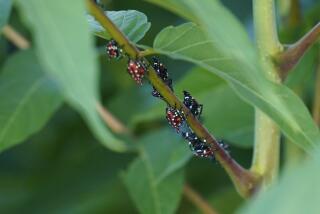Argentine Ants Mellow Out in California, Conquer State
- Share via
LA JOLLA — They are the ants that swarm your kitchen after heavy rain. The ants that nurture aphids that suck your garden dry. The ants that march relentlessly through Southern California, driving away gentler native ants and even lizards that stand in their way.
They also are a puzzle.
Just why is it these Argentine ants do so well here, colonizing the state in untold numbers? And what gives the two-millimeter-long ants the power to defeat native carpenter and harvester ants that can be 10 times their size?
It may be because they are all genetically similar, a group of UC San Diego scientists suggest in a paper being published today. So they treat each other--even ants from distant colonies--as close kin.
Ants here don’t rip rivals from other colonies to shreds like normal Argentine ants. Instead of fighting, neighborly Californians generally concentrate on finding (and sharing) food, raising young and spreading the far reaches of their empire.
That empire, researchers believe, is essentially a huge super colony of Argentine ants that stretches from Mexico to near the Oregon border.
It is almost as if, like many of their human counterparts, the ants mellow out once they reach the Golden State and become stereotypically laid-back Californians.
“It’s really a testimony to the power of cooperation,” said Neil D. Tsutsui, a graduate student at UC San Diego and lead author of the paper being published in today’s issue of the Proceedings of the National Academy of Sciences.
Fighting Has Consequences
In their native land, Argentine ants live in colonies that are typically the size of a suburban lot and contain multiple queens. When they encounter Argentine ants from other colonies, perhaps at a promising food source like a dead rodent, they fight like crazed gladiators.
They lunge at each other, biting off legs and antennae and smearing each other with toxic chemicals. “It’s completely unambiguous. They just rip each other to shreds,” said David A. Holway, a postdoctoral researcher at UC San Diego.
A recent study led by Holway shows that fighting has its consequences. The study compared the success of two colonies that fought against two colonies that didn’t. The warmongers suffered high casualties on both sides, were less efficient at gathering food and ended the experiment with fewer workers and larvae.
The colonies of peaceniks, in contrast, boomed. They fought less, so they suffered fewer casualties. Perhaps most telling, workers were more productive. It was the insect equivalent of spending most of the defense budget on improving the work force and building nursery schools; the peace dividend was more food, eggs, larvae and pupae.
While the fighters defended their turf and tried to monopolize a food supply placed between the two colonies, the peaceful ants moved freely to the food and back and forth between colonies. Sometimes queens from different colonies even moved in with each other and became roommates.
At the time of that study, two years ago, it was known that most California ants did not fight with each other. But little was known about how the ants behaved back home in Argentina.
So the researchers drove through Argentina seeking out ant colonies and pairing ants from closely neighboring colonies in one-on-one combat in glass tubes. To their surprise, the foes ripped each other apart. But the same tests in California found that ants from San Diego didn’t fight with ants from as far away as San Francisco.
Because members of a colony don’t fight with each other, they theorize, the population remains essentially unchecked. It is no surprise the ants are the pest that exterminators say generate the most calls for removal.
It is their huge numbers--too large for even scientists to accurately estimate--that give the ants their edge. Although an individual ant is “kind of small and feeble” Tsutsui said, their superior numbers make them a menace to larger native ants that lose their nest sites and food sources to the newcomers.
“They’ll actually move into the nests [of other ant species], kill the queens and take over the colonies,” said Ted J. Case, a professor of biology at UC San Diego and head of the research team. “There are just so many of them--and they’ve got such an attitude--that they will take over.”
The loss of native ants also has meant decline for coastal horned lizards, UC San Diego graduate student Andrew Suarez recently found. The lizards don’t like the taste of the Argentines, which are loaded up with bitter chemical weapons.
“They taste terrible,” said Tsutsui, who, like others in the group who collect ants by inhaling through rubber tubes, has occasionally sucked in a mouthful.
The crowning work for the group’s theory was a genetic analysis undertaken by Tsutsui. Using DNA fingerprinting techniques, he found that Argentine ants from different nests appear to be less closely related than ants from different nests in California. In both places, ants that shared fewer genetic markers were more likely to fight, he found.
The tests show that ants from across California share more DNA and have less genetic diversity, than those in Argentina.
The group concludes that the low genetic diversity in California is the result of ants here having passed through a “genetic bottleneck.” That means the billions of ants spread across California today may have come from relatively small sets of individuals that traveled to America in waves during the late 1800s on coffee and sugar ships or in plants.
They hit New Orleans first and successfully colonized many parts of the Southeastern United States. In recent years, they have been pushed out of many areas there by red imported fire ants, considered even more pesky because of their painful bites.
Other ant experts said they found the new research intriguing, but cautioned that the new study doesn’t fully explain why Argentine transplants thrive.
“I don’t think it is yet clear that the lack of aggression explains the success of the species,” said Deborah M. Gordon, an ecologist at Stanford who studies the structure of ant colonies and has spent seven years watching Argentine ants slowly take over much of Stanford’s Jasper Ridge Biological Preserve.
The success of the ants in California, she and others suspect, may also be due to the lack of serious competition from other South American ants and predators like parasitic flies.
Kenneth G. Ross, an expert on fire ants at the University of Georgia, said the UC San Diego group had done a good job gathering evidence to support an association between genetic similarity and a lack of aggression. In 1996, Ross suggested that a similar mechanism might be responsible for the ferocious spread of fire ants in the Southeastern United States.
Like Argentine ants here, North American fire ants have larger colonies that hold larger numbers of unrelated queens. In South American colonies, foreign queens are quickly dethroned, he said.
But Ross cautioned that the UC San Diego team had only shown an association between the two factors, and had not shown what might be causing the different levels of aggression or the apparent loss of the ability to discriminate between ants from different colonies.
Most researchers suspect that ants recognize by using their antennae to sample the hydrocarbons each ant secretes onto its tough outer structure, or cuticle. But very little is known about the workings or genetics of this recognition process. “That’s just a big black box in insect biology right now,” said Ross.
Questions also remain about why some maverick ants in California do fight and why some in Argentina are surprisingly peaceful.
If future work proves that genetic bottlenecks are a key to insect invasions, it could suggest a radical strategy: bringing in ants from Argentina that are the same species but are genetically dissimilar from those in California. The rival ants, it is reasoned, could simply kill each other off.
But it is unlikely that will happen any time soon. Altering genetics on a population level is considered dangerous because it could cause unforeseen and even larger problems, said Tsutsui. And it is unclear how a smaller colony of newcomers could survive amid a mega-colony. If the theory is right, ants from the larger colony would quickly recognize the new ants as foreign and kill them off.
The team is now working on a technique that could trick the ants into killing themselves off. If they find a way to change the hydrocarbon signature on half the ants in an area, they could start devastating civil wars within colonies.
“I’m not out to do pest control,” said Case, himself a victim of a household ant infestation. “But it would be nice.”
(BEGIN TEXT OF INFOBOX / INFOGRAPHIC)
Colonizing California
According to researchers at UC San Diego, California is home to a huge super colony of Argentine ants that stretches from the Mexican border nearly to Oregon. Because members of a colony don’t fight with each other, the population is largely unchecked. A look at where the ants live:
*
Source: Andrew Suarez, UC San Diego






